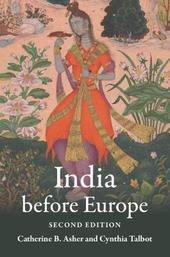
|
India before Europe
Paperback / softback
Main Details
| Title |
India before Europe
|
| Authors and Contributors |
By (author) Catherine B. Asher
|
|
By (author) Cynthia Talbot
|
| Physical Properties |
| Format:Paperback / softback | | Pages:350 | | Dimensions(mm): Height 227,Width 152 |
|
| Category/Genre | Asian and Middle Eastern history |
|---|
| ISBN/Barcode |
9781108448901
|
| Classifications | Dewey:954.02 |
|---|
| Audience | |
|---|
| Edition |
2nd Revised edition
|
| Illustrations |
Worked examples or Exercises
|
|
Publishing Details |
| Publisher |
Cambridge University Press
|
| Imprint |
Cambridge University Press
|
| Publication Date |
8 September 2022 |
| Publication Country |
United Kingdom
|
Description
India is a land of enormous diversity. Cross-cultural influences are everywhere in evidence, in the food people eat, the clothes they wear, and in the places they worship. This was ever the case, and at no time more so than in the India that existed from c. 1200 to 1750, before European intervention. In this thoughtfully revised and updated second edition, readers are taken on a richly illustrated journey across the political, economic, religious, and cultural landscapes of India - from the Ghurid conquest and the Delhi Sultanate, through the rise and fall of the southern kingdom of Vijayanagara and their successors, to the peripheries of empire, to the great court of the Mughals. This was a time of conquest and consolidation, when Muslims and Hindus came together to create a literary, material, and visual culture which was uniquely their own and which still resonates today.
Author Biography
Catherine B. Asher is an art historian, focusing on the interaction between Muslims and non-Muslims. She has served as President of the Historians of Islamic Art, Vice President of the College Art Association and Chair of the CAA International Committee as well as Chair of the CAA Publications Committee. She has been Treasurer of the American Council for Southern Asian Art and Chair of the American Institute of Indian Studies Center for Art and Archaeology. Her publications include Delhi's Qutb Complex: The Minar, Mosque and Mehrauli (Marg Foundation); The Architecture of Mughal India (Cambridge University Press); and Perceptions of South Asia's Visual Past (American Institute of Indian Studies). Cynthia Talbot is a social and cultural historian whose research has focused on both south and north India. After studying temples and brahmins for years, in recent decades her interests have shifted to heroic histories and warrior culture. Her publications include Precolonial India in Practice: Society, Region, and Identity in Medieval Andhra (Oxford University Press) Knowing India: Colonial and Modern Constructions of the Past (Yoda Press) and The Last Hindu Emperor: Prithviraj Chauhan and the Indian Past, 1200-2000 (Cambridge University Press), which received the Association for Asian Studies A.K. Coomaraswamy book award in 2018.
Reviews'A delightful and incisive book, the second edition of India before Europe is a must-read for students of history. It combines the insights of a historian and art historian to dynamite effect as it narrates social, religious, artistic, and political developments in second-millennium South Asia.' Audrey Truschke, Rutgers University 'What happens when two veteran scholars of premodern South Asia write a book about the 600 or so years leading up to the onset of British rule in India? They produce something wonderfully wide ranging and accessible, in whose prose is combined great personal insight and knowledge of the finest scholarship. I have used this text for all my South Asia survey classes for over a decade and am very grateful for this updated second edition.' Munis D. Faruqui, University of California, Berkeley 'This second edition of India before Europe is no mere reprint of the original. The engagingly written text moves seamlessly from discussions of political structure and social-economic history to consideration of large-scale cultural processes and the physical realia of architecture, painting, and textiles. A splendid accomplishment.' Phillip B. Wagoner, Wesleyan University
|